
Electron Microprobe Dating of Monazite
Preliminary results of a workshop at NMT given by Michael J. Jercinovic (University of Massachusetts)
Method Overview
Assumption:
No non-radiogenic lead in monazite or at least very little
If you can precisely measure U, Th, and Pb (in ppm), you can solve this equation iteratively for lead to obtain an age

Map thin section with the microprobe
Ce, Fe, Y to find all monazite crystals
Map monazite grains
Th, Y, U to see chemical domains
Measure major elements for matrix corrections
Spot analyses
Measure: U, Th, Pb, Y (to correct for peak interference with Pb--a
minor correction)
Solve the age equation
Samples:
See an abstract of Williams et al., 1999 which describes the structural, metamorphic, and temporal setting for Proterozoic rocks in northern New Mexico and discusses the pervasive ~1.4 Ga metamorphic overprint of these rocks.
JB54: Tusas Mountains, Cerro Colorado near Ojo Caliente, NM. This sample is currently used at UMass to test analytical precision.
Our two spot microprobe ages of 1413±11 Ma and 1447±11 Ma are consistent with UMass results between 1.41 and 1.45 Ga (the grain average is 1.41 GA).
ARR96-114A & B: Rincon Range, Southern Sangre de Cristo Mountains just north of Mora, NM with an isotopic age of ~1.42 GA
This sample is a sillimanite nodule-quartz-muscovite schist. The outcrop it was taken from is part of a screen of supracrustal rocks intruded by the1.65 Ga Guadalupita pluton.
For further background information, see an abstract of Read et al., 1999 which summarizes the geologic setting of the monazites in this sample that have been dated isotopically at ~1421 Ma. It was hoped that the perhaps some remnant of Mazatzal metamorphism could be seen in these monazites from a sample thought to have experienced metamorphism both at ~1.65 GA and at ~1.42 Ga.
The probe data overall are consistent with the isotopic age, but with considerable variability (see the data spreadsheet, and the grain maps and images for details).
Data analysis
(download a 650 Kb Excel file)
The probe data files have been organized into a spreadsheet (modeled on the spreadsheet that Mike supplied) that computes the ages. Several improvements have been made:
- Error estimates analytical precision based on counting statistics
have been automated. The standard error of the mean didn't appear to
work very well for these analyses because of ambiguity regarding mixed
populations of ages in the sample monazites.
- The age is calculated using macros which iterate the age equations
until a solution is reached to 0.001 Ma. Be sure to read the comments
on the macros by editing them (you may need to configure Excel to use
the 'solver' module. One macro iterates for one column of ages and should
be used on the 'All data' sheet while the other iterates two columns
of ages on the error sheets -- e.g. 'Th 1sigma'.
- All of the worksheets in the ARR96-114-error-estimate.xls workbook
are cross linked (except for the 'standard error of mean' analysis.
This will allow rapid age and error calculations by entering new probe
analyses into the 'Data from probe files' columns highlighted in blue
on the 'All data' worksheet.
- Several sort columns (A,B,C) can be used to sort the data in spreadsheet in different ways (be careful). All the links on other sheets will be properly maintained, but the Age interation macro will need to be re-run for the error estimate sheets.
Images and element maps
ARR96-114A
Section Maps (click for more detail)
|
Optical
|
Backscatter
|
Fe |
Ce (labeled with monazite locations)
|
 |
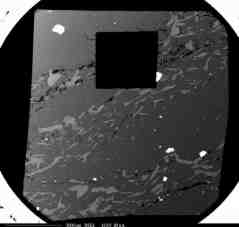 |
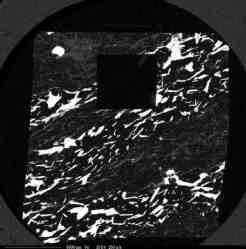 |
 |
Grain Maps (tone curves have been adjusted, so don't compare intensities from grain to grain)
|
#
|
BSE + age (click for details)
|
Th
|
U
|
Y
|
| 1 |  |
 |
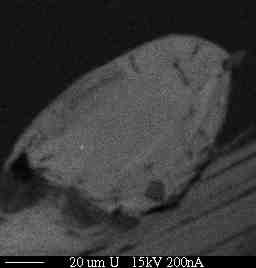 |
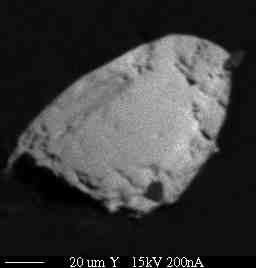 |
| 3 | 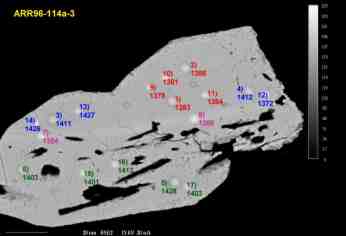 |
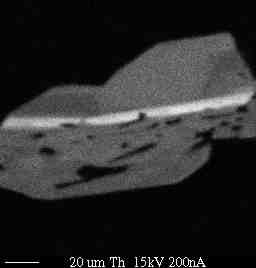 |
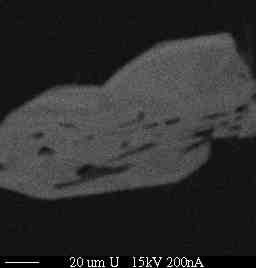 |
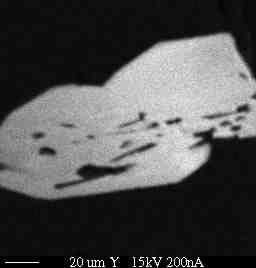 |
| 4 | 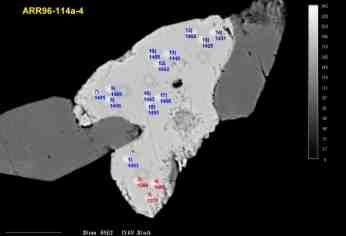 |
 |
 |
 |
ARR96-114B
Section Maps (click for more detail)
|
Optical
|
Backscatter
|
Fe
|
Ce (labeled with monazite locations) |
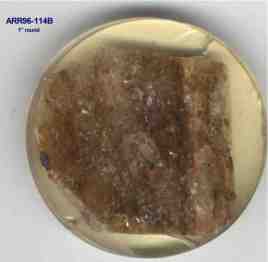 |
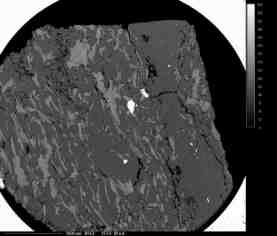 |
 |
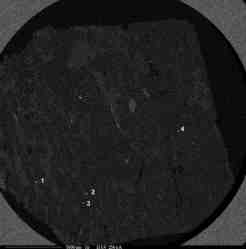 |
Grain Maps
|
#
|
BSE + age (click for details)
|
Th
|
U
|
Y
|
| 1 | 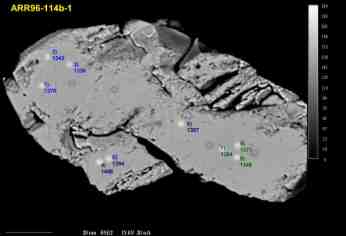 |
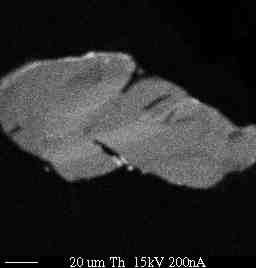 |
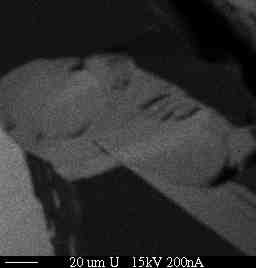 |
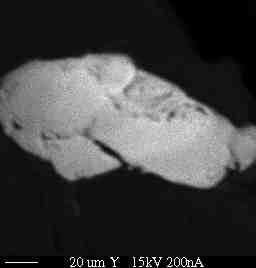 |
| 4 | 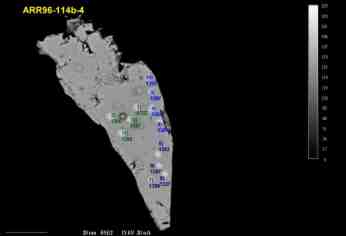 |
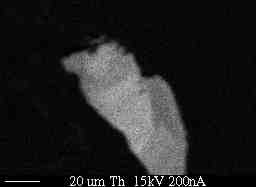 |
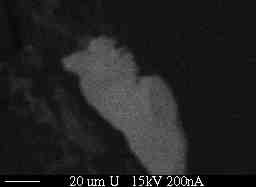 |
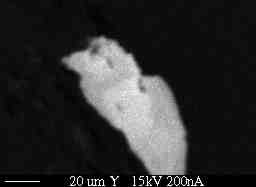 |
Conclusions
There are clearly age domains within the monazites analyzed from the Rincon Range that when averaged agree reasonably well with the isotopically derived age for these samples. However, we did not see any evidence for ~1.65 Ga monazite. This may be due to pervasive refabrication, fluid flux, and sufficiently high temperatures at ~1.4 Ga to recrystallize the monazite. Alternatively, this may imply that the inferred 1.65 Ga & 1.4 Ga polymetamorphism is not the correct interpretation. The oldest point analysis of 1527 Ma (sample ARR96-114A-grain 1, point 7) may be due to surface irregularity, a domain boundary, or some other analysis error. This may also be the case for the youngest age of 1251 Ma (same grain, point 22, very near the outer edge). Both the oldest and youngest points appear to be outliers and should probably be ignored in any case. The complex age domains, chemical zoning, and generally anhedral crystal morphology may collectively imply slow cooling at ~1.4 Ga and/or repeated magmatic-metamorphic pulses during the ~1.4 Ga tectonometamorphic event that in the Rincon Range may have lasted from perhaps 1460 Ma until 1380 Ma.
The best hope for finding older monazites in Proterozoic rocks from this and other ranges is likely to be within the cores of M1 garnets and other porphyroblasts. This will undoubtably be a very fruitful avenue of research for years to come.
Aknowledments
All of the participants at the workshop very much appreciate the time
and energy that Mike Jercinovic put into it. We look forward to utilizing
and improving this exciting new technique!
Thanks Mike.
Some method references
- Crowley, J.L., and Ghent, E.D. (1999) An electron microprobe study
of the U-Th-Pb systematics of metamorphosed monazite: The role of Pb
diffusion versus overgrowth and recrystallization. Chem. Geol. 157,
285-302.
- Montel, J.M., Kornprobst, J., and Vielzeuf, D. (2000) Preservation
of old U-Th-Pb ages in shielded monazite: example from the Beni Bousera
Hercynian kinzigites (Morocco). J. Metamorphic Geol. 18, 335-342.
- Suzuki, K., and Adachi, M. (1991) Precambrian provenance and Silurian
metamorphism of the Tsunosawa paragneiss in the South Kitakami terrane,
northeast Japan, revealed by the chemical Th-U-total Pb isochron ages
of monazite, zircon and xenotime: Journal of Geochemistry 25, 357-376.
- Suzuki, K., and Adachi, M. (1998) Denudation history of the high T/P
Ryoke metamorphic belt, southwest Japan: Constraints from CHIME monazite
ages of gneisses and granitoids. J. Metamorphic Geol. 16, 23-37.
- Suzuki, K, Adachi, M., and Kajizuka, I. (1994) Electron microprobe
observations of Pb diffusion in metamorphosed detrital monazites. Earth
and Planet. Sci. Lett. 128, 391-405.
- Williams, M.L., Jercinovic, M.J., Terry, M.P., (1999) Age Mapping and dating of monazite on the electron microprobe: Deconvoluting multistage tectonic histories, Geology, v. 27, no. 11, p. 1023-1026.


